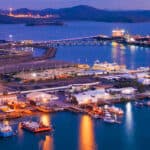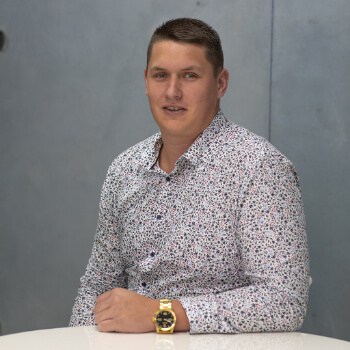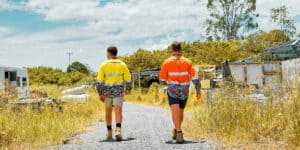DOUG: Welcome to this podcast in our Invisible Strength series by MARKHAM! Today, we’ve got Michael Coull from WSP in Queensland, Australia. Brief introduction: Michael is a Technical Executive with WSP, has a long experience in the planning, design, and construction of major coastal and port engineering and the infrastructure industry around the globe. He’s worked as a director of marine engineering, technical director, and design engineer for some of the largest engineering firms in the world.
So welcome, Michael!
MICHAEL: Yes, thanks, Doug. It’s great to be here with you this morning.
DOUG: Brilliant. Yes, looking forward to the session today. So just to kick us off, could you share some key points around your professional background and experience?
MICHAEL: Yes, sure, Doug. Thank you. I guess I’ve been working in the maritime space for many years, too many to count probably! I guess the first 10 years, I was working in client organizations, and in the past 33 or so years, been working as a consultant for two or three of the big consultant firms in the engineering space. I initially started my career with the Maritime Services Board in Sydney, back in late 1979. I guess I was fortunate to have a range of activities then, working on design of elements around the Sydney Harbour Area, did quite a bit of work for the number three Darling Harbour berths in Darling Harbour in Sydney. I did some coastal engineering work while I was with the Maritime Services Board, and then also got the opportunity to spend a couple of years doing contract management on some major berth construction, on a project in New South Wales as well. So quite a varied experience in those first couple of years.
I guess a few takeaways from those early experiences, some of that design work I was doing in early 1980 for the Darling Harbour project, now no longer exists. It was demolished as part of the Barangaroo redevelopment down there in Sydney, in around 2008. So had a lifespan, I guess, of about 25 years. But it’s probably relatively small in terms of the life we see of many of the marine and civil infrastructure that we design and build around the world. So we never know how long our project is going to last for. I guess the other takeaway is the project that I was involved in, in the construction in the early 80s, that berth is actually still being used 40 years later, now more than ever in its life. So interesting to see how things can be different for different projects.
As I was saying, I’ve been working in the maritime space for quite a few years. I had a few years with Mott MacDonald in the UK, was there for three years, and had some interesting design and contract management experience over there. The highlight, I guess, for me was working on a breakwater construction project in the north-east of England for about a year and a half, which was very interesting from a technical perspective. But also, personally, it was good, we got an opportunity to take a young family across to the UK for a couple of years. I guess from a personal perspective, we developed some fabulous friendships with people in that part of the UK, which we still maintain close contact with these days. So that’s interesting.
I guess more recently, over the last 13 years or so, I’ve spent a lot of time on overseas work, Doug, with probably 10 years of that time spent overseas, in the Middle East and Southeast Asia and also Canada, and little bit of work in South Africa as well. That’s been in a role of building maritime capability in the organizations in those different places, and doing a lot of work on port planning, feasibility studies, and also some design and project management work. So that’s a few highlights of many years of experience there.
DOUG: Yes, very interesting, and certainly a very valuable experience, especially working in different countries and different environments. I guess that kind of leads into our next segment there; in terms of your role there as a consultant, you’re obviously seeing a fair few challenges from climate change?
MICHAEL: Yes, sure. I guess there’s a few areas there. One of the biggest impacts we see, certainly working in the maritime space, is the impacts of sea level rise and what that means. In terms of the port community itself, I’ll say straightforward, and I suppose in terms of our design works, we can accommodate and make provision for future sea level rise in terms of the designs that we do. But I guess the biggest impact I see is on coastal communities, Doug, whether it’s what we see with the remote islands, say, around the Pacific or around the Indian Ocean, where sea level rise is going to have a huge impact on those locations, of course. But also in urban communities, where sea level rise has a big impact on those communities as well.
I’ve been doing work in Canada before I came back to Australia over the last couple of years, and there’s a lot of communities into the low-lying areas on the west coast of Canada where I was working. I guess seeing local government and provincial governments and the communities trying to understand those impacts and make provision for that in their planning in the years ahead. So it’s certainly a big challenge for those sorts of communities.
I guess that’s a particular focus of climate change. But the other challenge for us, as consultants and with those working in construction, and in keeping with what we see the emphasis being, nationally and internationally, is to look at reducing the emissions from our designs, to help reduce the impact of our designs on climate change. At WSP, we’re targeting to reduce the carbon footprint of our designs by 50% by 2030.
The other broad area in terms of the construction industry – the production and use of concrete is a big producer of carbon. I guess from an industry perspective, looking at ways we can reduce the carbon emissions from the production of concrete is something we need to be looking at. Looking at low-carbon concrete, use of alternative cement products, such as fly ash and granulated blast furnace slag cement replacement materials, is something that actually in the maritime space, we’ve been doing for quite a number of years. But more broadly, the use of those materials should be considered in the production of concrete, to help reduce the carbon emissions. Also, looking at specifications of our concrete to encourage the use of concretes that have lesser carbon emissions from their production as part of the specification.
DOUG: Perfect, that’s good. Thank you. Just back to the couple of points that caught my attention there. With the sea level rise, is there something more than we can just sort of build our way out of, like in terms of sea walls, or lifting structures, or designing structures to cope with it? Is it physically a case of having to shift locations of some assets or towns or whatever it may be?
MICHAEL: Well, sure. There’s a range of measures, and I guess adaptation being one of them to try and undertake some works that are going to mitigate the impacts of the sea level rise on the community or the area that’s impacted by it. I guess that adaptation can work in some areas. There’s other things you can do, perhaps if you’ve got a combination of sea level rise with wave impacts as well, maybe there’s some things you can do to try and reduce the wave impacts in combination with addressing the sea level rise. That can be an approach. But it might be a case that you need to actually retreat away from the coastline, and that’s a big challenge for communities and then for governments. I guess there’s some classic examples on the New South Wales coast, where properties have been built in areas with coastal erosion, and many areas where there’s low-lying areas that are going to be impacted by sea level rise. So there’s a combination of approaches there. Adaptation, if it works, and then perhaps retreat if you can’t get there.
DOUG: No, interesting. I like what you’re saying there around the marine industry often using, I guess you’d call it a more durable concrete from the get-go, because it’s got to last a distance, because downtime is not an option in a lot of cases. So pushing that out into other projects, I like that approach.
MICHAEL: Yes. One of the projects I worked in the UK, back in the late 80s, where we had, I think it was 70% ground granulated slag mixed in the concrete. That was, I guess, 30 odd years ago now. So I think that use of slag and other materials in concrete, and in some industries, it goes back well beyond that as well. But I think maybe in terms of a general industry, it’s not used as extensively.
DOUG: No, I agree.
So, Michael, could you tell us a bit more around WSP’s focus on the climate change issues, some of the things you’re working on there?
MICHAEL: Yes, sure. Thanks, Doug. One of the good things about WSP, it’s got what’s called a Future Ready framework. I guess when I joined WSP five years ago, it was something that I thought was really exciting. It’s an initiative that still exists and is ongoing, I guess stronger than ever now. Part of that is where we try to see the future more clearly and design for it today, and that’s our global innovation programme to do that. It’s built around four pillars, which is: society, resources, climate, and technology. So looking at any project that we’re involved in, it’s to look at the project and its elements and look at those aspects, and see what things look like in the future for that project, and then make sure we try to embody those features into our design.
So like with society, looking at people’s health, whether it’s physical health or mental health, and obviously the implications of COVID on society that we’ve seen over recent years, and trying to bring that into our design. In terms of resources, we’ve been talking about net-zero and halving emissions. So it’s looking at how we can reduce the emissions of our designs in our projects, and we have things like electrification. Certainly, in the port space, there’s a lot of automation electrification going on; we see electric vehicles becoming more and more prominent, so those sorts of things.
In terms of the climate pillar, looking at the sea level rise, and just beyond that, looking at more extreme events, whether it’s rainfall events or wave storms and things like that on the coast. I guess we’re seeing that sort of thing happening in northern New South Wales around Australia, with the large number of extreme flood events that have been happening in the last 12 months or so. So looking at those aspects is part of climate.
Then the fourth pillar being technology, I guess what we see is potential technology changes in the future, with electrification of vehicles, for example. We’ve got car parks and facilities for vehicles, so looking at what that means with the designs that we’re producing. So that’s the four main pillars of it, Doug: society, resources, climate, and technology. Trying to ensure that when we produce our designs, we’re looking to the future and we build opportunities into the design to make sure that what we’re designing today is ready for what is going to be happening in the future.
DOUG: That’s really good, Michael. I like how those can be quite challenging to look into the future, if you like. But there’s some real tangible areas that you can work on. I like that, that’s awesome.
MICHAEL: Yes, thanks, Doug. So it’s a really exciting programme, and we try to apply it to our projects as we’re going through. I guess it doesn’t fit every sort of project. But certainly, when we’re looking at our projects, we do our best to ensure that we’re addressing those aspects when we go through the work.
DOUG: Very good! And do you want to tell us a bit more about, you mentioned the 50% reduction there in emissions around WSP’s focus in the climate change area?
MICHAEL: Yes, we’re looking to reduce the emissions from our designs, as well as from our operations. So that’s an initiative that’s just been happening over the last six to nine months, Doug. So in terms of our internal operations, looking to reduce the emissions from the day-to-day things that we’re doing within the business, and also looking from the perspective of our designs that we produce, to reduce the emissions from those as well. That’s a developing space at the moment. It’s an initiative that’s just recently had been developed, and we’re looking at what that means in terms of real measures of things, and over the coming years, how we actually measure that and can say, Yes, we’ve achieved these things in our design. So that’s a work in progress in terms of the detail around that, but it’s a target that our business broadly has adopted here in Australia.
DOUG: Good, that’s awesome. Everybody has to have some initiative they’re working on, it’s not just to push it to one side nowadays.
MICHAEL: No, that’s right. I guess really in terms of talking about things like the concrete design, I think there’s some big winners to be made in the way we specify and use concrete, which is one of the main building products in many of the things that we design and get constructed.
DOUG: Can you say a bit more on concrete durability? You mentioned that project earlier, was it 70% slag there? Give us some more thoughts on that.
MICHAEL: In terms of the durability, I’ve seen some bad examples from a concrete durability perspective, Doug. I guess one of the projects I was involved in, I won’t say where it was, but I was involved in the construction of a project in the early 80s. Then, within 20 years, seeing that suffering some severe corrosion issues with chloride ingress. It was a suspended deck structure, and particularly the soffits of the beams and the underside of the slabs experiencing spalling of the concrete due to the chloride ingress in the concrete, which I was quite horrified when I found out. Having been involved on the site side of things and seeing the care that was put into ensuring that the project was constructed in accordance with the design, I was quite so horrified to see this outcome within 20 years of the construction.
I guess compared to these days, it was a poorly specified concrete. It was a 25 MPa concrete. It was a Type C Portland cement, which is what we were using back in the early 80s; not of a standard that was going to be durable, compared to the specifying of concrete that we see today for maritime structures, which is looking at 50 MPa concretes, having low-water cement ratios, and then having cement replacement that’s going to also enhance the concrete’s performance, whether it be through the inclusion of slag as a cement replacement material, or fly ash as well. Some projects I’ve been involved in, we’ve had some silica fume added as well. So looking at blends of the different products to enhance the performance of the concrete is certainly very beneficial.
I guess just in terms of performance of those concretes, I mentioned the low-quality concrete from a project I was involved in back in the 80s. Looking at projects these days, and the Port Botany project that was built over 10 years ago now. But the specification of that was, for design and construction project, required 100 years design life, as part of the concrete mix design. It required that the contractor and the concrete supplier actually do modelling of the concrete performance as part of their design, to ensure, from a chloride ingress perspective, that they’re going to achieve the 100-year design life in those elements of the reinforced concrete. So I guess a different approach to what it was quite a few years ago.
DOUG: Yes, it’s really important to have all the elements of the concrete mix right. It’s not one thing you have to do right, you have to do a whole lot of things right. It’s also, with the contract, as you mentioned, the ready-mix and the contractor, obviously yourselves as engineers, all those people have to be pulling together as well to get that end result.
MICHAEL: Yes, sure.
DOUG: Awesome, and any other major industry challenges you wanted to touch on?
MICHAEL: Yes. Well, I guess inflation is the big topic of the day and a lot of the news these days. Prices going up, and interest rates going up, and things like that. I guess, certainly over the last six or nine months, one of the big challenges in the construction and building industry is, there’s inflation of costs and materials and labour. There’s been some quite significant business failures in recent times, without mentioning them specifically. But I think price pressures, particularly on the construction industry contractors, with the inflation in the costs that are happening, and the potential impacts of that on these businesses, which impacts not just on the projects, but on people’s lives and livelihoods. So over the coming 12 months, I think that’s going to be an issue, in terms of clients and consultants and those businesses, looking at ensuring that the contractual provisions that exist within the building and construction contracts provide mechanisms to deal with significant increases in prices. Rather than just saying, well, it was a fixed-price contract that we signed six months ago. If we’re looking to sign one in the future, ensuring that there’s an equitable arrangement for ensuring that those cost increases can be managed by the construction industry.
DOUG: Yes, that’s a very valid point there. Because now is not the time to be forcing people to make shortcuts, if you want to put it that way, just because they haven’t got the budget for it. I think it’s really good to make sure there’s that provision there. Because yes, things never go wholly to plan, do they, on site?
MICHAEL: Well, no, certainly. I guess over the last 12 to 18 months, we have seen significant increases in the material costs. So in terms of the year or two ahead, one hopes that inflation gets under control. But as I said, ensuring equitable sharing of risk in that sense. I guess it’s not reasonable to expect contracting firms to accept risks that they really can’t estimate or know what they are at an early stage.
DOUG: Yes, that’s been really good, Michael! If our listeners today want to get in touch with you, what’s your preferred contact mechanism?
MICHAEL: Yes, sure, Doug. My email address is Michael.Coull@WSP.com; I’m also on LinkedIn. So they can either contact me through my WSP email, or get in touch through LinkedIn, if anyone wants to get in touch.
DOUG: Perfect, thanks very much. That’ll conclude our session today. You’ve been listening to Michael Coull from WSP in Queensland. I would like to thank him for his time, and hope this has been valuable for you as a listener. Thank you!
MICHAEL: Thanks, Doug. It’s been good to have a conversation with you.
DOUG: Yes, that’s awesome. Thank you very much!





